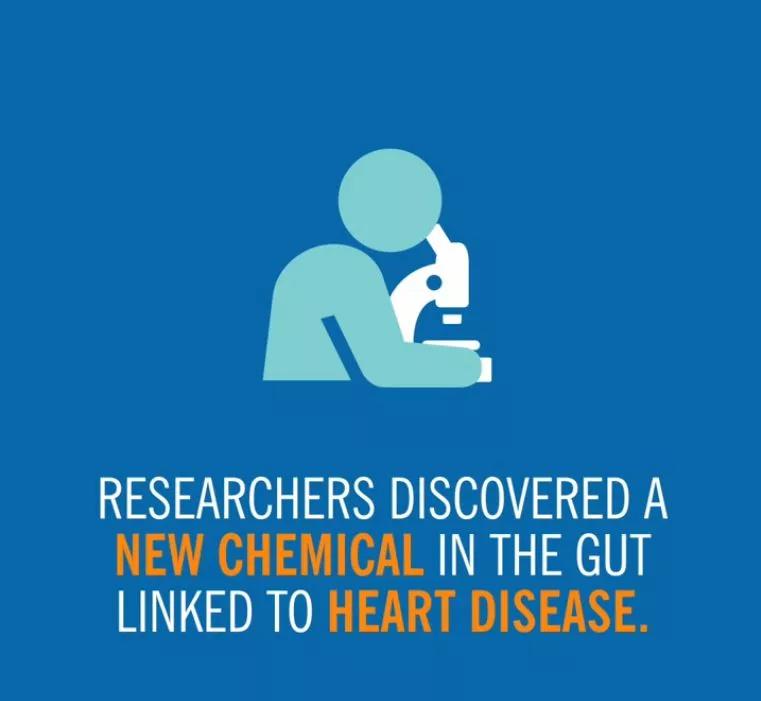images: 0
video: 1
audio: 0
text: 0
Content is property of Cleveland Clinic and for news media use only.


Cleveland Clinic researchers have identified a gut microbe-generated byproduct – phenylacetylglutamine (PAG) – that is linked to development of cardiovascular disease, including heart attack, stroke and death. The study was published in Cell today.
Phenylalanine is an amino acid found in many foods, including plant- and animal-based protein sources like meat, beans and soy. The researchers – led by Stanley Hazen, M.D., Ph.D., chair of the Department of Cardiovascular & Metabolic Sciences in Lerner Research Institute and co-section head of Preventive Cardiology & Rehabilitation in the Miller Family Heart, Vascular & Thoracic Institute – found that when phenylalanine is broken down by microbes in the gut, it produces a byproduct (metabolite) that ultimately shows up in blood called phenylacetylglutamine (PAG) that contributes to heart disease.
“Over the past decade there has been an increasing amount of data to suggest that gut microbes play a role in health, especially as it relates to heart disease,” said Dr. Hazen, who also directs the Cleveland Clinic Center for Microbiome and Human Health. “We found that blood levels of PAG contribute to cardiovascular disease risk in a couple of different ways.”
Analyzing samples from more than 5,000 patients over three years revealed that elevated PAGln levels predicted subjects who went on to experienced adverse cardiac events like heart attack and stroke in the future, and also in those with type 2 diabetes (an independent risk factor for cardiovascular disease). Animal model and microbe transplantation studies suggest the gut microbe-produced PAG can play an important role in driving cardiovascular disease.
The researchers also analyzed whole blood, platelet-rich plasma and isolated platelets from patient samples to understand how PAG affects cell processes. They then analyzed animal models of arterial injury to see how PAG induced cellular changes manifest into disease. Dr. Hazen and his team found that PAG enhanced platelet reactivity and clotting potential, which increases the likelihood of blood clots, a major cause of adverse cardiac events like heart attack and stroke.

“Part of the reason we were so interested to have made this discovery is because we found that PAG binds to the same receptors as beta blockers, which are drugs commonly prescribed to help treat cardiac diseases.” said Hazen. “We believe our findings suggest that some of the benefits of beta blockers may be attributed to preventing PAG – related activity. Beta blockers have been widely studied and are prescribed to many cardiac patients, but, to our knowledge, this is the first time that this mechanism has been suggested as an explanation for some of their benefits.”
Administering beta blockers to animal models with elevated PAG was shown to reverse cardiovascular endpoints driven by PAG. Additionally, researchers found that using gene editing technology or drugs to block PAG – receptor signaling significantly reduced clotting activity.
“Dr. Hazen’s team has expanded our understanding of specific gut microbial pathways that participate in diabetes and heart disease, and the potential for targeting them for treatment,” said Dr. Ahmed A.K. Hasan, a program director at the National Heart, Lung, and Blood Institute, part of the National Institutes of Health. “Overall, this study uses novel tools, and shows how the food we eat is linked, via gut microbes, to our health, and disease risks. It could help personalize cardiovascular medicine in the future.”
Ina Nemet, Ph.D.; Prasenjit Saha, Ph.D.; and Nilaksh Gupta, Ph.D., are co-first authors of the present study, which was supported by the National Heart, Lung, and Blood Institute (part of the National Institutes of Health) and the Leducq Foundation.
Cleveland Clinic is a nonprofit multispecialty academic medical center that integrates clinical and hospital care with research and education. Located in Cleveland, Ohio, it was founded in 1921 by four renowned physicians with a vision of providing outstanding patient care based upon the principles of cooperation, compassion and innovation. Cleveland Clinic has pioneered many medical breakthroughs, including coronary artery bypass surgery and the first face transplant in the United States. Cleveland Clinic is consistently recognized in the U.S. and throughout the world for its expertise and care. Among Cleveland Clinic’s 82,600 employees worldwide are more than 5,786 salaried physicians and researchers, and 20,700 registered nurses and advanced practice providers, representing 140 medical specialties and subspecialties. Cleveland Clinic is a 6,728-bed health system that includes a 173-acre main campus near downtown Cleveland, 23 hospitals, 280 outpatient facilities, including locations in northeast Ohio; Florida; Las Vegas, Nevada; Toronto, Canada; Abu Dhabi, UAE; and London, England. In 2024, there were 15.7 million outpatient encounters, 333,000 hospital admissions and observations, and 320,000 surgeries and procedures throughout Cleveland Clinic’s health system. Patients came for treatment from every state and 112 countries. Visit us at clevelandclinic.org. Follow us at x.com/CleClinicNews. News and resources are available at newsroom.clevelandclinic.org.
Editor’s Note: Cleveland Clinic News Service is available to provide broadcast-quality interviews and B-roll upon request.